You have come to the right place if you are looking for the best mid-trap exercises to build stronger and larger traps. Get an incredibly muscular body with developed trapezius muscles.
Trap training is so much more than just endless shrug variations. To really build up the traps, you should try to hit all its aspects: the upper, lower, and middle traps.
Although every trap exercise hits all three muscle fibers to some degree, certain trap exercises are better than others at stressing the different muscle fibers because of the biomechanics involved.
Now, you may think, I need another workout routine to add to my already packed schedule. Don’t worry.
This blog is here to make your life easier, not more complicated. I’ll share simple, effective exercises you can easily add to your routine or do during a home workout.
We will provide you with various methods to train the mid-trap.
- Bodyweight Mid-Trap Exercises
- Middle trap exercises with dumbbells
- Barbell Middle Traps Exercises
- Mid-Trap Workout With Cable
Your Free Calculator To Know Your BODY MASS INDEX
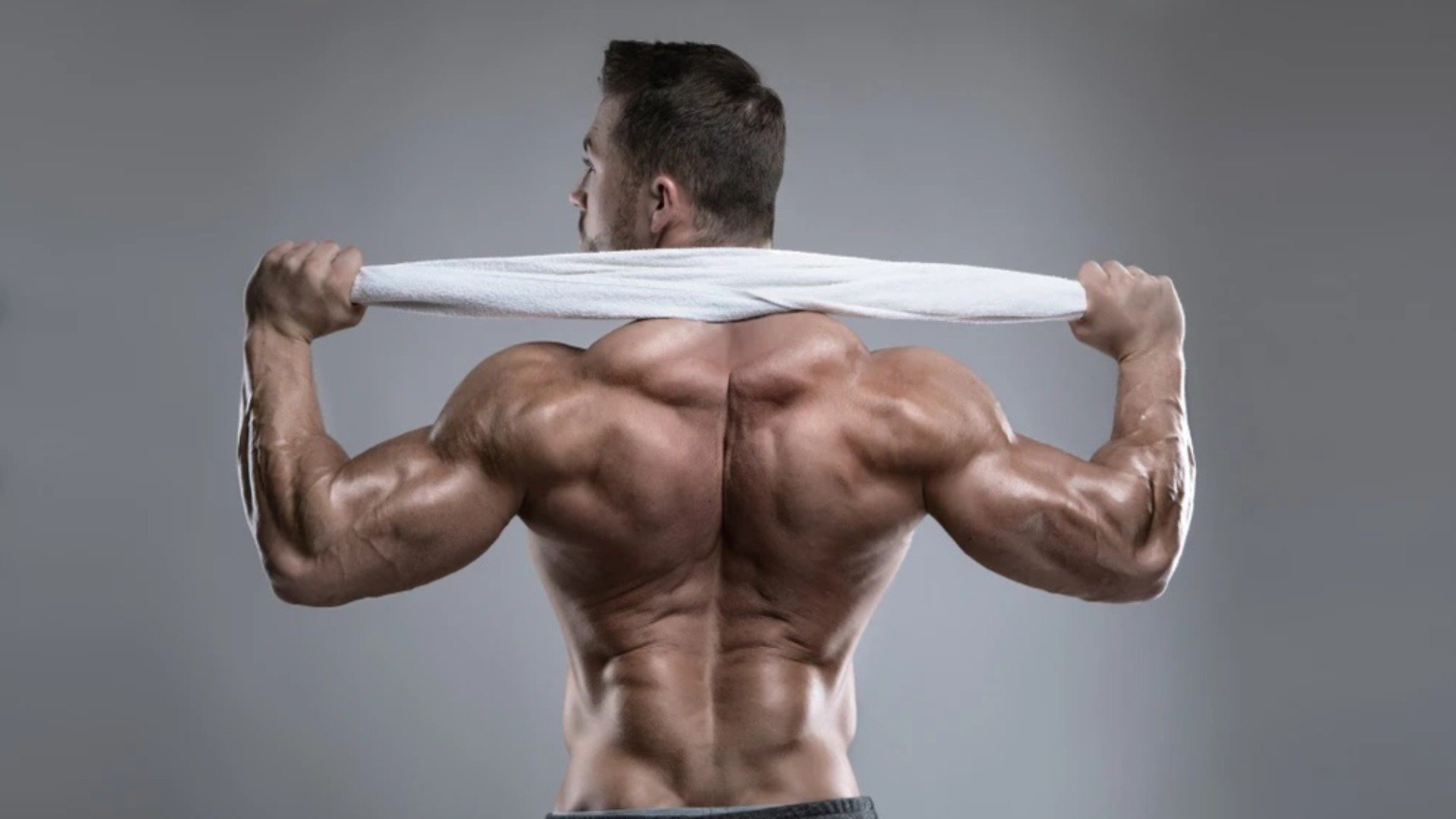
- How to Train Middle Trap
- 12 Best Middle Trap Exercises
- 1. I, Y, T, W
- 2. Inverted Row
- 3. Incline Dumbbell Y-Raise
- 4. Bent Over Dumbbell Lateral Raise
- 5. Bent Over Dumbbell Row
- 6. Shrug
- 7. T Bar Row
- 8. Barbell Rear Delt Row
- 9. Cross Body Y Raise
- 10. Face Pull
- 11. Seated Cable Rows
- 12. Cable Upright Row
- Middle Trap Workout Routine
- 1. Shoulder-Focused Workout Routine
- 2. Upper Body Strength And Definition Routine
- 3. Full-Body Strength And Stability Routine
- 5 Best Mid-Trap Stretches
- FAQs
- Cause of weak middle trapezius?
- How to strengthen the weak middle trap?
- How do you strengthen your middle traps?
- Bodyweight exercises for mid-traps
- How Can I Build My Middle Trapezius At Home?
How to Train Middle Trap
If you’ve ever seen big dudes with massive traps, like professional wrestler Brock Lesnar, you’ll find that a lot of the thickness in their traps comes from well-developed mid-traps.
The trapezius, aka trap, is a large muscle in your back. It starts at the base of your neck and extends across your shoulders and down to the middle of your back. It looks like a trapezoid (a shape with four sides, two of which are parallel).
Healthcare providers categorize the trapezius into three areas, and each area helps you with a specific kind of movement. Together, they help you move your head, stand up straight, bend or twist your torso, and raise your arms.
- Upper fibers (Upper trapezius)
- Middle fibers (middle trapezius)
- Lower fibers (Lower trapezius).

The mid-trap originates from the spinous processes of the first four thoracic vertebrae and runs across the shoulders to help stabilize your shoulder movement.
The primary actions of the mid-traps are:
- Scapular Retraction (squeezing your shoulder blades together): Pulling the shoulder blades towards the spine.
- Scapular Upward Rotation (to a lesser extent): Assisting in rotating the shoulder blades upwards, especially when combined with other muscles.
- Scapular Depression: Pulling the shoulder blades downwards.
Therefore, exercises such as bent-over rows, face pulls, seated rows (which involve scapula retraction), and Y raises, overhead carries (which involve upward rotation) will effectively target the middle trapezius.
The middle traps should be worked sufficiently for growth with many of the big compound back exercises. They are a primary mover for most of the best back exercises, like rows.
Even if you want to give mid-trap workout more attention, keep in mind the following points.
- These muscles respond best to high repetition and can be effectively worked with lighter weights.
- Establish a strong mind-muscle connection. Focus on feeling the contraction in the middle of your back between your shoulder blades during each rep.
Use Free Calculator To Know Your Muscle Building Calories Requirement
12 Best Middle Trap Exercises
Now, let’s get into the best mid-trap exercises for mass and strength, using various types of fitness equipment.
The middle trap exercises have been divided into many sections, including bodyweight, dumbbells, barbell and machine, and cable middle trap exercises.
1. I, Y, T, W
These exercises focus on the shoulder and back muscles, mainly the middle and lower part of the trapezius.
They also hit all the rotator cuff muscles, including the infraspinatus, subscapularis, teres minor, and supraspinatus muscles.
These work together to stabilize the shoulder and move the arm. For a healthy shoulder, you must add these exercises to your bodyweight workout regimen.
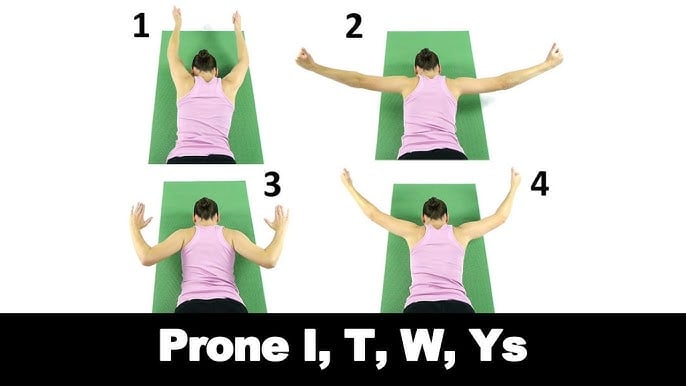
How To Do
- Gently exhale and slowly lift your arms off the floor (maintain a formation of the letter “I, W, T”).
- Keep your head aligned with your thoracic (upper) spine.
- Focus on using your shoulders to generate most of the lift, although some low back extension (arching) is acceptable.
2. Inverted Row
The inverted row (bodyweight rows) is one of the best bodyweight middle traps you can easily do at home. This movement forces your shoulder blades to retract and depress, which activates your mid-traps.
They simultaneously target your mid and lower traps, rhomboids, and rear delts. But the best part is that they also work your biceps and core. It’s like exercising your entire upper body in one move.
But, you can also perform the inverted row at home by lying under a chair, holding the chair’s sides, and pulling yourself up.

How To Do
- Find a sturdy bar or table edge at about waist height.
- Lie underneath it and grab the bar with an overhand grip, slightly wider than shoulder-width
- Extend your legs out in front of you, heels on the ground (Beginners, keep your knees bent).
- Engage your core and keep your body straight from head to heel.
- Pull your chest up to the bar and squeeze your shoulder blades together.
- Inhale as you lower your body until your arms and shoulders are fully extended. Repeat.
Tips
- Do not allow your butt to sag. Flex your tummy, squeeze your butt cheeks, and keep your body stiff from your head to your toe.
- Start with an easier angle (higher bar) and progress to a more challenging angle (lower bar) as you get stronger.
Know More: 20 Best Trap Workout and Exercises for Mass and Strength
3. Incline Dumbbell Y-Raise
Y Raises are a great and easy-to-do shoulder stability exercise that targets the rotator cuff muscles and your mid and lower traps.
Although the Y Raise is commonly performed on an incline bench, it can be modified to suit your needs and performed in various ways: standing, lying on the floor, on a flat or incline bench, or even on a Swiss ball.
As you raise your arms up and out in a Y shape, your mid-traps, rear delts, and rhomboids contract to lift the weight against gravity.
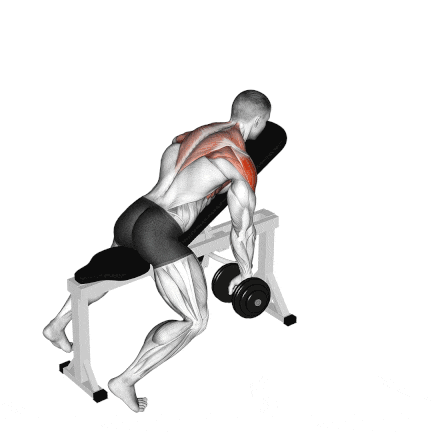
How To Do
- Adjust an incline bench to a 30-45 degree angle.
- Lie face down with your chest supported and feet on the floor.
- Hold a dumbbell in each hand with a pronated grip (palms facing down)
- Retrace your shoulder blades (pulling them together) and then raise your arms up and out to form a Y shape.
- Hold this position for two seconds before returning the dumbbells to the starting position.
Tips
- Raise arms up in a slow, controlled manner.
- Be careful not to put too much weight on your deltoids, as it is easy to injure them.
4. Bent Over Dumbbell Lateral Raise
Bent over raises are an excellent exercise to isolate and work specifically on rear deltoid and mid-trap muscles. For complete shoulder muscle development, bent-over raises are a must-do.
You can do it standing up or sitting down. I prefer the seated option, as it requires strict movement.
There are many variations of bent-over lateral raise that you can add to your workout routine. Each has unique benefits.
- Dumbbell Bent Over Raise: Enhances shoulder stability with free weights.
- Cable Rear Delt Lateral Raise: Constant tension for efficient muscle activation.
- One-Arm Rear Bent Over Raise: Improves symmetry and targets rear deltoid isolation.
- Resistance Bands Bent Over Lateral Raise: Portable option for rear delt training.
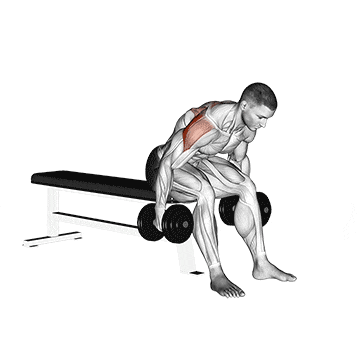
How To Do
- Grab a pair of dumbbells with a neutral grip and sit at the end of the bench.
- Keep your back straight and lean forward until almost your chest touches your legs.
- Let the dumbbells hang on your sides.
- Keep your elbows slightly bent, and raise your arms to the sides until they align with your shoulders.
- Now lower the dumbbells back to your sides
Tips
- Keep strict form to isolate the rear delts.
- Don’t bring your arms up too high – up to shoulder height is far enough.
- Don’t rush through your reps! Hold for a second at the top of the movement.
5. Bent Over Dumbbell Row
When you do this exercise, you primarily work on scapular retraction (pulling your shoulder blades together) and elbow flexion. It is great for working upper back muscles, including the middle trap, lats, rhomboids, and rear delts.
What I love about this exercise is how versatile it is.
- You can switch up your grip (palms facing back or palms facing each other) to target slightly different areas.
- You can do them one arm at a time for extra core engagement.
- You can even support them on a bench if you work on form or have lower back issues.
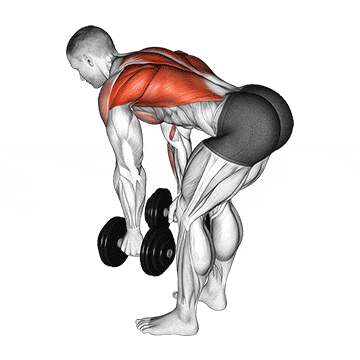
How To Do
- Stand with your legs shoulder-width apart and knees slightly bent.
- Hold a dumbbell in each hand with a neutral grip. Let the dumbbells hang straight down near your knee.
- Bend over at a 45-degree angle and maintain a straight back.
- Raise the dumbbell until it touches the abdominal region, not the chest region, as this reduces back muscle contraction.
- Lower the dumbbell slowly to its starting position.
Tips
- Do not use more weight than you can handle. This fatigues your spinal erectors and says goodbye to form.
- Keep movement always under control without letting gravity take you down faster.
6. Shrug
Shrug exercises are a great way to strengthen the muscles of the upper back, shoulders, and trap. I used to think shoulder shrugs were just for bodybuilders, but I was wrong.
After adding them to my workouts, I noticed that my trap size and strength increased, and I could lift heavier weights during workouts.
There are several shrug variations you can do with a dumbbell, barbell, cable, or Smith machine to develop massive traps.
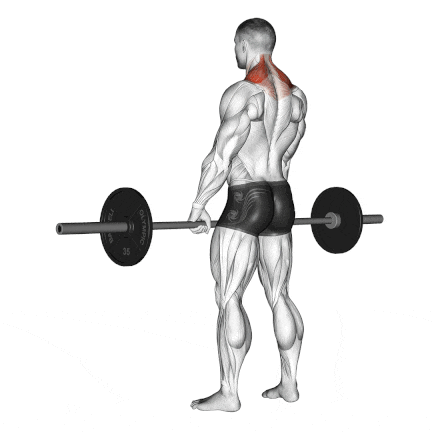
How To Do
- Stand tall with your feet shoulder-width apart and toes slightly pointed outward.
- Hold a barbell with an overhand grip, slightly wider than shoulder-width apart. You can experiment with grip width to see what feels most comfortable.
- Let the barbell hang in front of your thighs at arm’s length.
- Keep your arms straight and shrug your shoulders straight up towards your ears as far as possible.
- Hold the contracted position for a brief pause, squeezing your traps maximally.
- Slowly lower the barbell back to the starting position by depressing and relaxing your shoulders.
- Do 8–10 reps and 3–4 sets for muscle hypertrophy.
Tips
- Focus on lifting the weight with your traps and not your biceps.
- Pausing at the top of the barbell shrug makes the exercise more challenging and you’ll get more out of it.
- Do not roll your shoulders as this can lead to a shoulder injury.
7. T Bar Row
The T-bar row is a compound exercise that involves multiple muscle groups.
You can perform the T-bar row using various grips (neutral, wide, close), angles (using a landmine attachment or T-bar machine), and foot positions to emphasize different muscle groups and add variety to your workouts.
Because you can use both hands, you can load more weight, which gives the T-bar an edge over dumbbell rows. The only catch is that many gyms don’t have a T-bar row station.
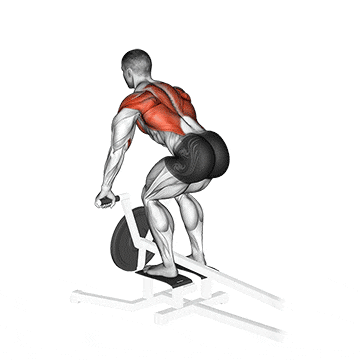
How To Do
- Standing on a T-bar machine, grab its handles with an overhand grip. Keep your feet a bit apart and your knees slightly bent.
- Bend at the hips and keep your back arched throughout the movement.
- Lift the bar until it touches your chest, and keep your ping the back straight.
- Now, slowly lower the bar until it nearly touches the ground.
Tips
- Exhale while you exert.
- Avoid hunchback bending as it leads to Injury.
- Go complete range of motion.
8. Barbell Rear Delt Row
Unlike traditional rows that primarily target your lats and rhomboids, the rear delt row greatly emphasizes your rear deltoids and mid-Trap.
This exercise primarily involves shoulder horizontal abduction (moving your arms out to the sides) and scapular retraction (pulling your shoulder blades together). This combination makes it so effective for training rear delts and mid-traps.

How To Do
- Stand with your feet shoulder-width apart, holding a barbell with a wide overhand grip (higher than shoulder width).
- Bend your knees and hinge at the hips. Keep your back flat and almost parallel to the ground.
- Pull the barbell up toward your upper chest and squeeze the rear delt.
- Slowly go back to the initial position as you breathe in.
Tips
- Start lighter than you think you need to. This is not an exercise where you are training the lat; you are training the rear delt.
- Refrain from using your biceps to do the work. Focus on targeting the rear delts; the arms should only act as hooks.
9. Cross Body Y Raise
If you’re looking for a way to get more creative with your cable shoulder workout, why not try cable Y-raise?
It is a fantastic exercise for the whole shoulder (deltoid) that activates all deltoid fibers (anterior, lateral, and posterior) and trap.
This exercise combines horizontal shoulder abduction with external shoulder rotation. It is strengthening the external shoulder rotators and the internal shoulder rotators.
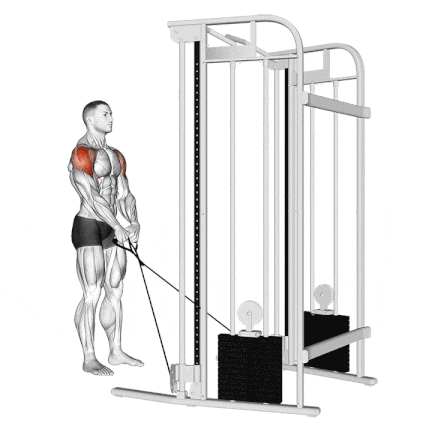
How To Do
- Stand facing between two low cable pulleys, with each hand holding the handle of the cable of the opposite pulley.
- Push your chest forward and point your shoulders back while slightly bending both knees to maintain good posture.
- Stand straight up with your arm fully extended and feet facing forward.
- Maintaining a slight bend in the elbows, raise your arms upwards and outwards, forming the letter ‘Y’ with your whole body.
- Hold for a second, and then slowly lower the weight back to the starting position.
Tips
- Maintain a fixed, slightly bent elbow position throughout the exercise.
- Keep your torso still, your back straight, and your elbow slightly bent.
- Don’t just swing your arms. Keep controlled motion throughout the exercise
10. Face Pull
Face pull is another great exercise for your cable trap workout. It is a cable machine exercise that primarily targets the rear deltoid and traps to a lesser degree and also targets the biceps, triceps. Use a cable pulley machine to pull the weight straight toward your forehead.
This trap exercise and workout type prevents muscular imbalance and builds overall shoulder strength.
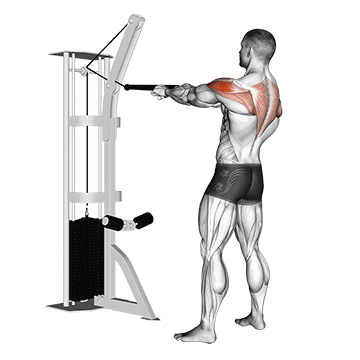
How To Do
- Grab the ends of the rope attachment using a neutral grip (palms facing each other) and slightly lean back.
- Pull the rope toward your face as you spread the ends of the rope so they end up on the sides of your ears just above your shoulders in the finish position.
- Hold this position for as second as you squeeze your shoulder blades together, contracting rear delts and middle traps as hard as possible.
- Then, slowly return the rope to the start position.
Tips
- Stand straight with feet in a comfortable, balanced stance.
- Be sure to exhale when pulling weight toward your face.
- Think about trying to pinch your shoulder blades as tight as possible when pulling weight toward your face.
- Your upper arms should be straight out to your sides with elbows bent.
11. Seated Cable Rows
Seated Cable Rows is an excellent exercise to build middle back muscles and this works on mid and lowers lats as well. It can be done with wide and narrow gareps.
- A pronated (overhand) grip tends to target the ,middle and upper trthe apezius,
- Whereas, a neutral (thumbs up) grip hits the middle and lower trapezius.
- A supinated (underhand) grip switches the focus to the latissimus dorsi.
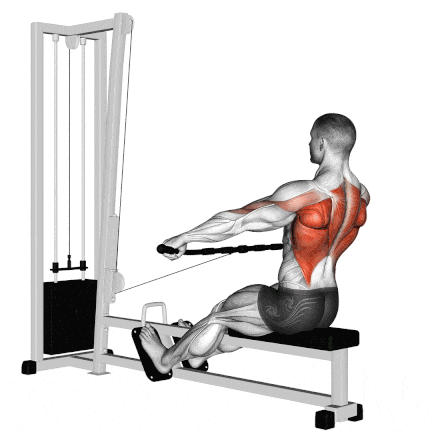
How To Do
- Sit on a seated cable pulley rowing machine with legs slightly bent and feet supported against the crossbar.
- Take hold of the handles with your arms extended and back stretched.
- Pull the handles to come as close to the lower chest/abdomen as possible.
- Thrust your chest out while pulling with your body in upright position.
- Slowly return the handle to the starting position.
Tips
- Pause briefly when the handles are close to the chest and squeeze your upper back muscles, bringing the scapulae closer.
- Keep your knees slightly bent to avoid knee and lower back pressure.
- Keep your upper back stationary, don’t move your upper back, back, and forth.
12. Cable Upright Row
Finally, if you’re looking for one more effective cable middle trap e;ercise, try the cable uprigt row
Upright rows are an exercise that nearly everyone can do using a wide variety of grip widths.
Cable machines keep tension on the muscles throughout the entire range of motion, ultimately increasing muscle activation and hypertrophy.
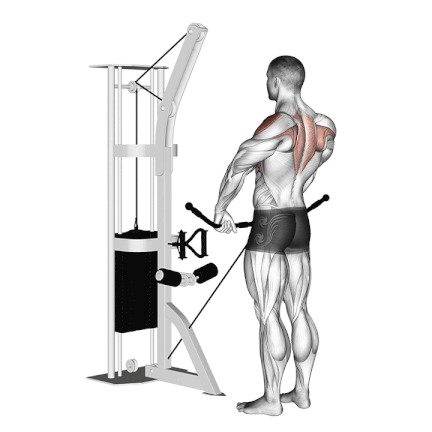
How To Do
- Attach a straight bar to a low cable pulley. Grab the bar using a shoulder-width or wider overhand grip.
- Stand close to the pulley with your body upright, your shoulders pulled back.
- Exhale as you pull the bar up the front of your body until it reaches your lower or middle chest level.
- Do not pull the bar up any higher. Hold for a count of two. Inhale as you lower the bar to the starting position.
Tips
- Bend slightly at the knees and stand with feet shoulder-width apart.
- Keep your shoulders back, chest out, and body upright.
Middle Trap Workout Routine
They can be incorporated into your workout routine in various ways. Here are some options:
- As a standalone exercise: Do on 3-4 sets of 8-12 reps.
- As part of a shoulder workout: Do them along with other shoulder exercises.
- As part of a full-body workout: Do them with other compound exercises like squats, deadlifts, and bench presses.
1. Shoulder-Focused Workout Routine
| Exercise | Sets | Reps |
|---|---|---|
| Rear Delt Fly | 4 | 10-12 |
| Seated Shoulder Press | 3 | 8-10 |
| Lateral Raises | 3 | 12-15 |
| Front Raises | 3 | 10-12 |
| Face Pulls | 3 | 12-15 |
2. Upper Body Strength And Definition Routine
| Exercise | Sets | Reps |
|---|---|---|
| Barbell Rows | 4 | 8-10 |
| Pull-Ups | 3 | 8-10 |
| Dumbbell Bench Press | 3 | 8-10 |
| Seated Cable Rows | 3 | 12-15 |
| Triceps Pushdowns | 3 | 10-12 |
3. Full-Body Strength And Stability Routine
| Exercise | Sets | Reps |
|---|---|---|
| Deadlifts | 3 | 6-8 |
| Squats | 4 | 8-10 |
| Bent-Over Rows | 3 | 8-10 |
| Machine Rear Delt Fly | 3 | 12-15 |
| Incline Dumbbell Curl | 3 | 8-10 |
| Plank | 3 | 30 sec |
5 Best Mid-Trap Stretches
Stretches for the middle trapezius are a great way to relieve neck, shoulder, upper and middle back pain.
Stress, posture, and work habits contribute to an increase in pain and tight trapezius muscles.
There are numerous ways to perform trapezius stretches, and here, you will find five of the best trapezius stretches. These stretches can be performed in various positions to stretch the different parts of the muscle.
- Child’s Pose with side reaches
- Ear to shoulder
- Chin Tucks
- Tennis-Ball Massage
- Cat-Cow pose
FAQs
Cause of weak middle trapezius?
If your middle trapezius is weak, you are likely to have rounded shoulders. This is really common because so much of what we do hunches our bodies forward, such as sitting at a computer, on the couch, lying on our side at night in bed, and so on.
If it is functionally weak, you may experience shoulder pain when hanging the laundry, putting dishes away in high cabinets, or when walking the dog.
How to strengthen the weak middle trap?
There are some good exercises you can try at home or at the gym to strengthen the weak middle trap muscle. These should be combined with a push exercise and a squat for general strength gains. Strength exercises to try at home are a row using a resistance band, an inverted row, and push-ups.
How do you strengthen your middle traps?
To build bigger, stronger middle traps, you should add the exercises mentioned above to your upper body training sessions. Mid-trap muscles can be developed through common exercises such as seated rows and Y-raises, which involve pulling the shoulder blades together.
Bodyweight exercises for mid-traps
To build your middle traps, you can do many bodyweight exercises at home. Try Inverted Rows, pull-ups, and Y-raises.
How Can I Build My Middle Trapezius At Home?
If you invest in a good set of dumbbells, you can do many exercises at home to build your mid-traps. Try bent-over dumbbell lateral raise, Y-Raise, and Dumbbell Bent-over Row.
Reference
- Schoenfeld, Brad MSc, CSCS; Kolber, Morey J PT, PhD, CSCS; Haimes, Jonathan E BS, CSCS: The Upright Row: Implications for Preventing Subacromial Impingement. Strength and Conditioning Journal: October 2011 – Volume 33 – Issue 5 – p 25-28
- Ronai, Peter MS, CSCS, RCEP: Exercise Modifications and Strategies to Enhance Shoulder Function. Strength and Conditioning Journal: August 2005 – Volume 27 – Issue 4 – p 36-45
- McAllister M, Schilling B, Hammond K, Weiss L, Farney T. Effect of grip width on electromyographic activity during the upright row. J Strength Cond PMID: 22362088 DOI: 10.1519/JSC.0b013e31824f23ad
- Lorenzetti S, Dayer R, Pluss M, List R. Pulling exercises for strength training and rehabilitation: movements and loading conditions. J Funct Morphol Kinesiol. 2017;2(3):33. doi:10.3390/jfmk2030033

Manish brings over 10 years of hands-on experience in weight lifting and fat loss to fitness coaching. He specializes in gym-based training and has a lot of knowledge about exercise, lifting technique, biomechanics, and more.
Through “Fit Life Regime,” he generously shares the insights he’s gained over a decade in the field. His goal is to equip others with the knowledge to start their own fitness journey.
